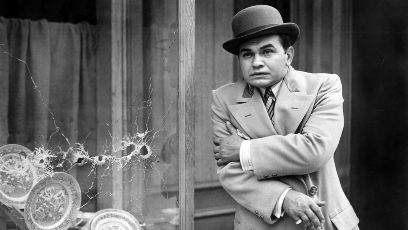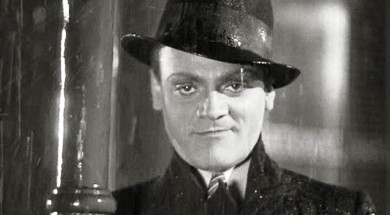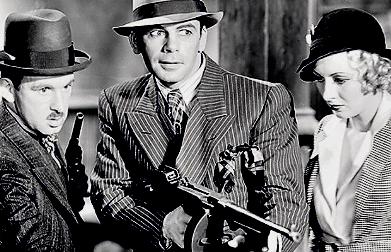
In 1931 and ’32, the gangster genre broke through in Hollywood with three great films: Little Caesar, The Public Enemy, and Scarface.
The gangster movie has been a durable genre, along with the western, one of the uniquely American film types. There had been such films in the silent era, but the early 1930s was when they suddenly took off. Three Hollywood films in particular, all made within roughly the same year, were the origin points for just about everything that came after, a kind of unholy trinity of crime pictures.
 The first one was Little Caesar, released by Warner Brothers in 1931, directed by Mervyn Leroy, and starring Edward G. Robinson as Rico Bandelli, a Chicago mob boss based loosely on Al Capone. Robinson’s performance made him a star, and endless comedians since have parodied the character’s mannerisms, with “Myeah myeah! I’m the boss. See?” and so forth. Robinson’s work in the film is much more subtle than this caricature—revealing Rico’s brutality, suspiciousness, and animalistic enjoyment of power. The Warners were cutting costs by cutting their movies for speed, which encouraged economy of means and expression. LeRoy excelled at this. In one great sequence, a couple pairs of legs walk swiftly into a room, we hear shots, a body falling, and then a glimpse of the killers’ hats as they turn and flee. All in mere seconds. The movie was a box office hit, despite the usual concerns of the moral crusaders always looking askance at Hollywood.
The first one was Little Caesar, released by Warner Brothers in 1931, directed by Mervyn Leroy, and starring Edward G. Robinson as Rico Bandelli, a Chicago mob boss based loosely on Al Capone. Robinson’s performance made him a star, and endless comedians since have parodied the character’s mannerisms, with “Myeah myeah! I’m the boss. See?” and so forth. Robinson’s work in the film is much more subtle than this caricature—revealing Rico’s brutality, suspiciousness, and animalistic enjoyment of power. The Warners were cutting costs by cutting their movies for speed, which encouraged economy of means and expression. LeRoy excelled at this. In one great sequence, a couple pairs of legs walk swiftly into a room, we hear shots, a body falling, and then a glimpse of the killers’ hats as they turn and flee. All in mere seconds. The movie was a box office hit, despite the usual concerns of the moral crusaders always looking askance at Hollywood.
 The second picture, released later the same year, was called The Public Enemy, also at Warners, which in the ‘30s was the one studio focused more on urban working class stories more than fantasies about rich people. William Wellman, a veteran with a reputation for risk-taking, was the director. His intuition for talent helped him here: James Cagney was cast as the main character’s sidekick, but after seeing him work, Wellman switched the two actors, putting Cagney in the lead as Tom Powers, a tough Irish mobster from Chicago. His performance is stunning, full of wild scary energy, speedy wisecracking, and jaunty belligerence. I’ll never forget the look in his eyes when Powers, in the pouring rain, gets ready to enter a gathering of enemies with guns blazing. It’s absolutely chilling. The expert editing and sound make this film stand out as one of the true greats.
The second picture, released later the same year, was called The Public Enemy, also at Warners, which in the ‘30s was the one studio focused more on urban working class stories more than fantasies about rich people. William Wellman, a veteran with a reputation for risk-taking, was the director. His intuition for talent helped him here: James Cagney was cast as the main character’s sidekick, but after seeing him work, Wellman switched the two actors, putting Cagney in the lead as Tom Powers, a tough Irish mobster from Chicago. His performance is stunning, full of wild scary energy, speedy wisecracking, and jaunty belligerence. I’ll never forget the look in his eyes when Powers, in the pouring rain, gets ready to enter a gathering of enemies with guns blazing. It’s absolutely chilling. The expert editing and sound make this film stand out as one of the true greats.
 The third movie, released early in 1932, was Scarface, made by Howard Hawks for a small outfit run by millionaire Howard Hughes. It starred the famous and well-regarded actor Paul Muni as Tony Camonte, yet another Chicago gangster (honestly, there were other cities that had gangs) inspired by Al Capone. Of the three films, this one’s the most violent. Tony is a barely literate homicidal monster who tears relentlessly through gangland with machine guns, and to top that, has an unacknowledged romantic obsession with his own sister. The picture is also pretty funny—Hawks highlighting all the most exaggerated criminal fantasies and revenge scenarios he could come up with. The guardians of virtue attacked this film in particular as glorifying criminals, and Hawks was forced to put a little prologue before the story, telling the audience that crime doesn’t pay. Incidentally, there’s no point comparing this to the Al Pacino film from the ‘80s. The only thing really similar is the title.
The third movie, released early in 1932, was Scarface, made by Howard Hawks for a small outfit run by millionaire Howard Hughes. It starred the famous and well-regarded actor Paul Muni as Tony Camonte, yet another Chicago gangster (honestly, there were other cities that had gangs) inspired by Al Capone. Of the three films, this one’s the most violent. Tony is a barely literate homicidal monster who tears relentlessly through gangland with machine guns, and to top that, has an unacknowledged romantic obsession with his own sister. The picture is also pretty funny—Hawks highlighting all the most exaggerated criminal fantasies and revenge scenarios he could come up with. The guardians of virtue attacked this film in particular as glorifying criminals, and Hawks was forced to put a little prologue before the story, telling the audience that crime doesn’t pay. Incidentally, there’s no point comparing this to the Al Pacino film from the ‘80s. The only thing really similar is the title.
The unholy gangster film trinity: Little Caesar, The Public Enemy, and Scarface, all released in 1931 and ’32, are available on streaming platforms and on DVD and Blu-ray.

